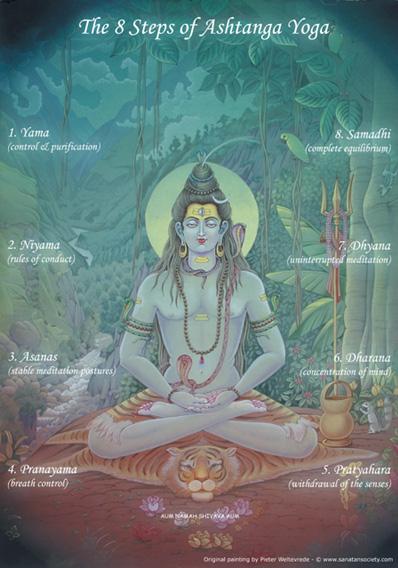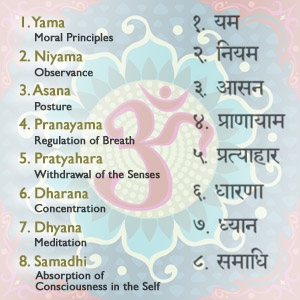Ashtanga Yoga
Ashtanga Yoga is the eight-folded path of yoga. It is a specific yoga tradition, but at the same time Ashtanga Yoga can be seen as covering all aspects of yoga within any yoga tradition.
Ashtanga Yoga is often called Patanjali Yoga, referring to Maharishi Patanjali, the ancient author of the famous Patanjali yoga sutras that describe Ashtanga Yoga. Historians place the writing of these scriptures at around 200 B.C., but the original is probably thousands of years older. These teachings belong to an oral tradition, passed on unchanged by memorisation of the verses in which their wisdom was captured. More recently (15th century) the term Raja Yoga is also often used instead of Ashtanga Yoga, meaning "royal yoga".
Ashtanga Yoga can be regarded as a fourth option next to the 3 typical paths of yoga, namely bhakti, karma and jnana yoga. While these yogas rather directly aim at dissolving the ego, Ashtanga Yoga does the same job but more indirectly through mind. The second sutra of Patanjali already makes it clear : by stopping the modifications of mind the objective of yoga is reached. In other words, stop thinking long enough and the ego will no longer be fed by concepts. As the ego is nothing but a body of concepts, it thus dissolves through a process called Samadhi (effortless meditation) and merges with cosmic consciousness, which is the union that is yoga.
As Ashtanga Yoga also includes many aspects of bhakti, jnana and karma yoga, it is an extremely powerful yogic tradition. Stopping mind is not exactly easy, but the eight methodical steps of Ashtanga yoga make it possible for anyone to achieve that goal. Step by step, kosha by kosha, all obstacles to stop mind are removed and the attention is brought inside untill the meditation becomes effortless and the dissolution of the ego can start.

Following is an overview of the 8 limbs of Ashtanga yoga, described as practices :
. Yama (control) : a series of don'ts in contact with the world outside, so that your relationships as well as your energy remain harmonious, providing the peaceful background needed for deep meditation. The disciplines in Yama typically include nonviolence, truth, honesty, sexual continence, forbearance, fortitude, kindness, straightforwardness, moderation in diet & bodily purity.. Niyama (rules of conduct) : a series of do's that helping in detaching from the world and the ego, so that it becomes easier to let go of the doer in deep meditation. Activities in Niyama typically consist of austerity, contentment, belief in God, charity, worship of God, study of teachings and scriptures, modesty, having a discerning mind, repetition of prayers, observance of vows and performing sacrifices.
. Asana (posture) : as a motionless body makes the mind quiet, and as an unstable body cannot remain motionless in deep meditation (when the I am the body idea is lost), many postures have been described of which at the least one sitting posture must be mastered in order to reach a deep state of meditation. a . Pranayama (control of breath) : control of breath brings mind under control, while the main aim is to store the energy that will be needed when in deep meditation breathing has stopped.
. Pratyahara (withdrawal of sensory perceptions) : removing the attention from sensory input, so that it ceases to disturb meditation. This may be preceded by some focus on purifying sensory input, such as in rituals, use of meditative sounds, etc... Ultimately prana is withdrawn from the nadis that transport sensory input.
. Dharana (concentration) : the focus of mind on any single object, for example a mantra, or deep concentration on the six subtle centers of the chakras, starting from the first and gradually approaching the seventh, etc...
. Dhyana (uninterrupted meditation) : in which the concentration is uninterrupted, without a single disturbing thought, though this concentration still requires some effort.
. Samadhi (effortless meditation, absorption, equilibrium) : concentration is maintained, but it requires no effort. The doer has disappeared from consciousness. This stage allows for a rather long purification process through which the individual consciousness is finally dissolved in pure cosmic consciousness. After a prolonged practice of samadhi there is no need to practice any longer, because the conscious connection to the divine is everlasting, which is called natural samadhi (sahaj). Ultimately it leads to enlightenment.

